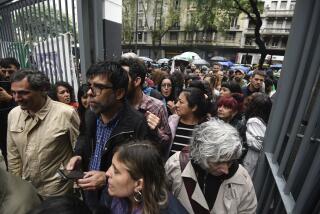Italians Hurl Abuse, Produce at Union Leader : Economy: Amid monetary crisis, protesters revile labor boss for agreeing to government’s austerity plan.
- Share via
ROME — Angry workers surged through the Renaissance heart of Florence on Tuesday, pelting the leader of Italy’s largest union with rotten vegetables and calling for nationwide strikes to protest government austerity.
Up to 100,000 protesters jammed Florence’s tourist-beloved Piazza Santa Croce to revile union boss Bruno Trentin, who supports the austerity program. They peppered him with potatoes, tomatoes, eggs, bolts--and devalued lire.
The demonstration, which ended without major injuries or arrests, marked the first massive grass-roots protest against Italy’s economic mess in the context of Europe’s monetary crisis.
It will not be the last. Unions across the country have scheduled regional strikes against new taxes and painful cuts in health care and pensions.
In the flux, the lira was a no-show Tuesday at its promised return to the European Monetary System. Treasury officials originally said the lira would quickly return to a rate system it left in distress last week. But when markets opened Tuesday, it was clear that the Italian lira, like the British pound, was probably months away from rejoining Europe’s dismembered currency accord.
Neither was the Bank of Italy willing to officially fix the lira’s value, relying again--and apparently for the foreseeable future--on an informal rate established in the marketplace. The bank’s rate Tuesday for the dollar was 1,240 lire; the rate is informal because the central bank is not obliged to defend it in the event of a selloff.
At American Express in the Piazza di Spagna, tourists were getting 1,205 lire for $1; those wanting to buy dollars, by contrast, had to pay 1,290 lire for each dollar. Exchange rates, which will continue to vary from bank to bank, showed a modest recovery for the lira Tuesday.
But, bottom line, they spelled good news for American visitors: In one of Europe’s most expensive countries, dollars are worth about 10% more than they were before the European currency crisis exploded Sept. 13. “We’re advising customers to use their cards when possible--the exchange rate is better than with cash or travelers’ checks. And we’re hoping that in the long run, the lower lira will mean a return of more American tourists,” said Isabella Montezemolo, an American Express official.
Don’t come expecting bargains, though. Assuming a 1,200 to 1 rate, a Big Mac hamburger was steady at $4 in central Rome, while a copy of the International Herald Tribune eased to $2.
Humiliated by two back-to-back devaluations of the lira last week, the government of Socialist Prime Minister Giuliano Amato is being forced to balance Italy’s books. It seeks to slash a 1993 budget deficit by a whopping $76 billion, reducing services and increasing taxes in about equal measure.
A long budget debate is in prospect in a divided Parliament, although Amato vowed Tuesday that he would not back off from any of the austerity measures.
Supported by hard-line Marxists who split from the former Communist Party, Italian unions charge that--as usual--it is the working class that is being asked to pay for decades of government excess.
Union boss Trentin has lost the support of many workers because he agreed with the Amato government to accept austerity measures, including a freeze on pensions, pay increases and hiring. Union members see family hardships ahead because of service cutbacks.
He and other union leaders are also under fire for agreeing with Amato and employers in July to surrender time-honored indexed increases under which salaries marched in step with living costs.
The Italian economy is flat--this week, auto giant Fiat announced a furlough of 52,000 workers. And unions anticipate a rise in inflation, now running at 5.3% a year, as a consequence of devaluation.
To protest the austerity package that Amato unveiled after Italy retreated from the monetary system last week, unions have scheduled four-hour strikes by regions.
More to Read
Sign up for Essential California
The most important California stories and recommendations in your inbox every morning.
You may occasionally receive promotional content from the Los Angeles Times.













